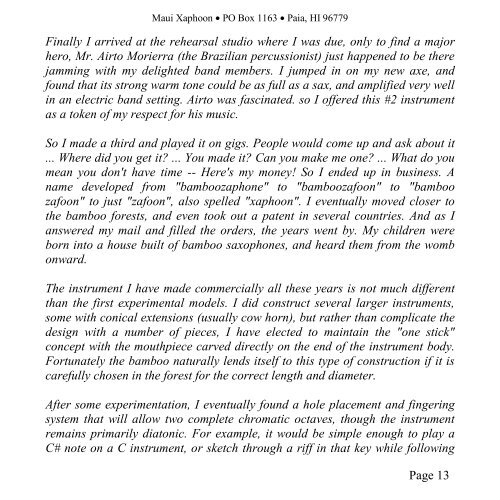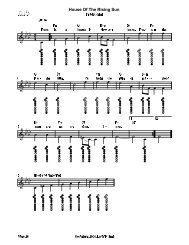Xaphoon
Cover Page - Xaphoon.com
Cover Page - Xaphoon.com
Create successful ePaper yourself
Turn your PDF publications into a flip-book with our unique Google optimized e-Paper software.
Maui <strong>Xaphoon</strong> • PO Box 1163 • Paia, HI 96779<br />
Finally I arrived at the rehearsal studio where I was due, only to find a major<br />
hero, Mr. Airto Morierra (the Brazilian percussionist) just happened to be there<br />
jamming with my delighted band members. I jumped in on my new axe, and<br />
found that its strong warm tone could be as full as a sax, and amplified very well<br />
in an electric band setting. Airto was fascinated. so I offered this #2 instrument<br />
as a token of my respect for his music.<br />
So I made a third and played it on gigs. People would come up and ask about it<br />
... Where did you get it? ... You made it? Can you make me one? ... What do you<br />
mean you don't have time -- Here's my money! So I ended up in business. A<br />
name developed from "bamboozaphone" to "bamboozafoon" to "bamboo<br />
zafoon" to just "zafoon", also spelled "xaphoon". I eventually moved closer to<br />
the bamboo forests, and even took out a patent in several countries. And as I<br />
answered my mail and filled the orders, the years went by. My children were<br />
born into a house built of bamboo saxophones, and heard them from the womb<br />
onward.<br />
The instrument I have made commercially all these years is not much different<br />
than the first experimental models. I did construct several larger instruments,<br />
some with conical extensions (usually cow horn), but rather than complicate the<br />
design with a number of pieces, I have elected to maintain the "one stick"<br />
concept with the mouthpiece carved directly on the end of the instrument body.<br />
Fortunately the bamboo naturally lends itself to this type of construction if it is<br />
carefully chosen in the forest for the correct length and diameter.<br />
After some experimentation, I eventually found a hole placement and fingering<br />
system that will allow two complete chromatic octaves, though the instrument<br />
remains primarily diatonic. For example, it would be simple enough to play a<br />
C# note on a C instrument, or sketch through a riff in that key while following<br />
Page 13





